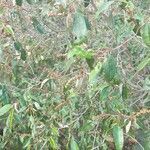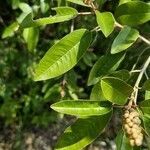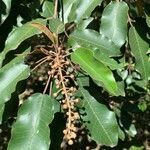Male flowers fragrant; pedicels 1–3(5) mm long; buds 1.5–3.5 mm in diameter, subglobose, yellowish-lepidote; sepals 5, 4 × 2.5 mm, ovate, densely tawny-lepidote or rusty-lepidote without, stellate-pubescent within, greenish-yellow; petals 5, 4 × 1.5 mm, elliptic-oblong, sparingly rusty-lepidote without, puberulous within, ciliate, pale creamy-yellow to whitish; disk glands 5, truncate, glabrous; stamens 17–22, filaments 3–4 mm long, sparingly gland-dotted, otherwise glabrous, pale yellow, anthers 1.5 mm long, with a broad glandular connective, yellow; receptacle pubescent.
A shrub or small tree. It grows 6 m tall. It has a pleasant scent. Young stems are hairy. There are scaly hairs underneath the leaves. The leaf blade is dark above and white underneath. Leaves are 4 cm long by 2 cm wide. Male and female flowers are separate on the same plant. There are a few female flowers and more male flowers. The fruit are 7 mm across. They are capsules with 3 lobes. They are covered with scales. They are green and turn yellow.
Female flowers: pedicels 2–3 mm long, extending to 5 mm in fruit, stouter than the male, densely lepidote; sepals and petals ± as in the male; disk scarcely distinguishable; staminodes 4–5, 1.5 mm long, subulate-filiform; ovary 2.5 mm in diameter, globose, densely brown-lepidote; styles 3, 1 mm long, spreading, 2-partite with irregularly multifid segments, abaxially lepidote, adaxially glabrous, dull dark purple.
Bole up to 40 cm d.b.h.; bark rough and longitudinally or rectangularly fissured on lower trunk, smooth on upper trunk, dark grey to pale brownish-grey, patterned.
A shrub or tree up to 12 m tall, monoecious or sometimes dioecious; trunk usually Y-forked with drooping branches; crown sparse, open, rounded or ± pyramidal.
Racemes 1–15 cm long, erect at first, later drooping, terminal, androgynous or all male; axis angular; bracts 2–3(5) mm long, subulate, soon falling.
Seeds 7 × 5.5 × 3 mm, compressed-ellipsoid, smooth, slightly shiny, light brown; caruncle 1.5 mm wide, pentagonal, flattened.
Fruits 8–10 × 8–11 mm, trilobate-subglobose, septicidal, densely greenish-or yellowish-to silvery-lepidote, brown-flecked.
Branches often in whorls of 3.Young twigs rusty-lepidote to fulvous stellate-lepidote.
Stipules 1.5–7 mm long, subulate-filiform.
Petioles 0.5–7 cm long.





